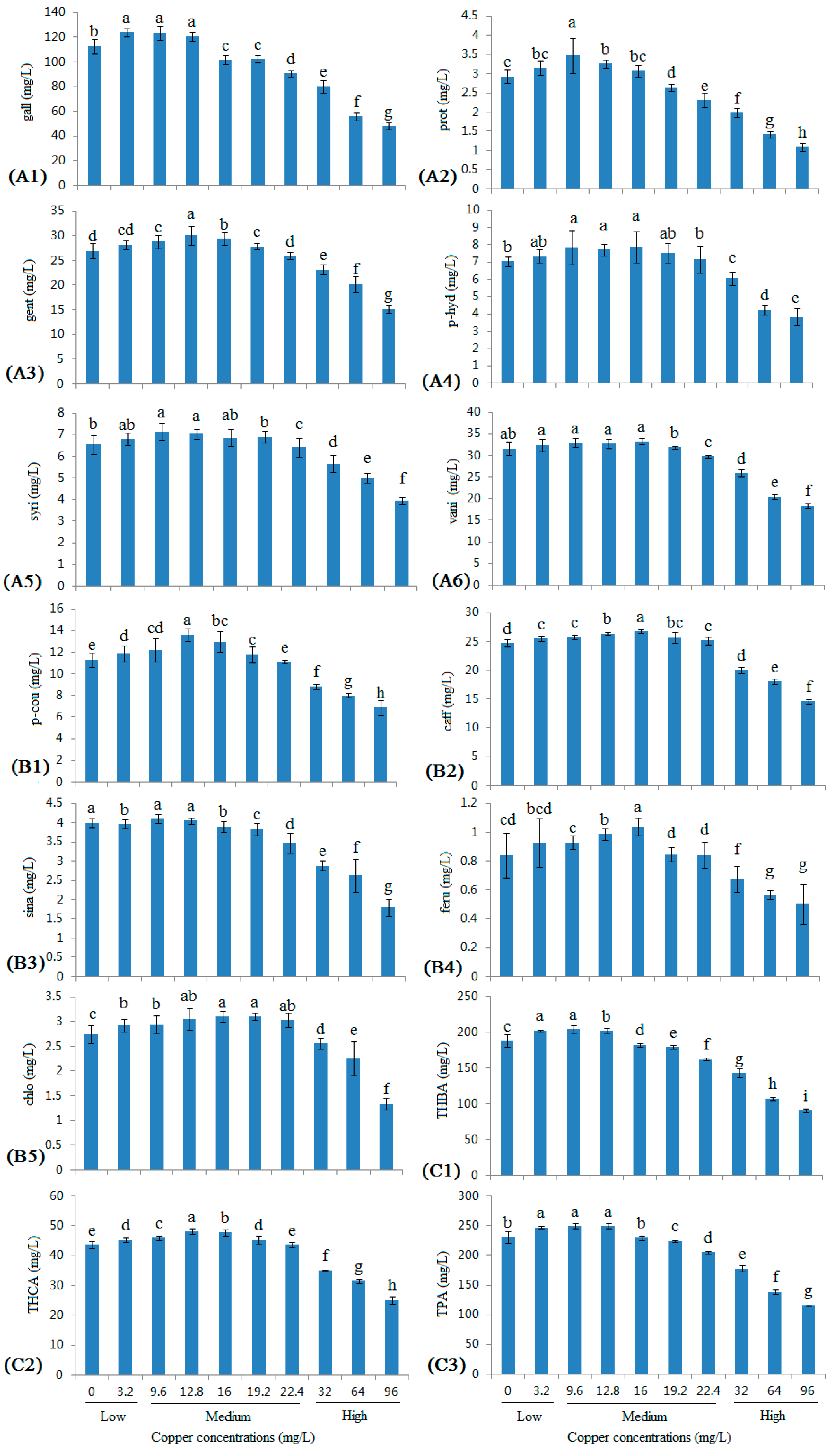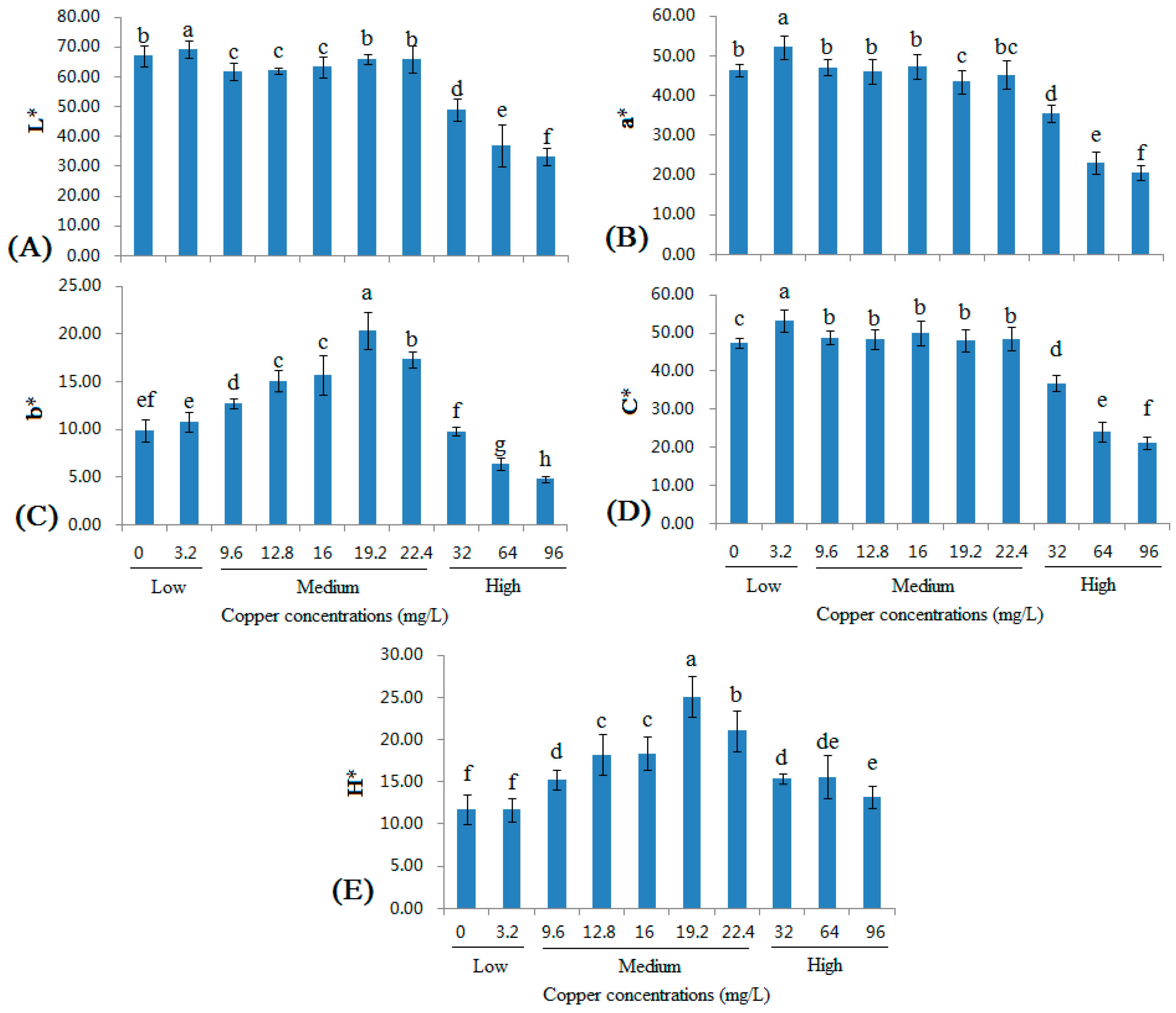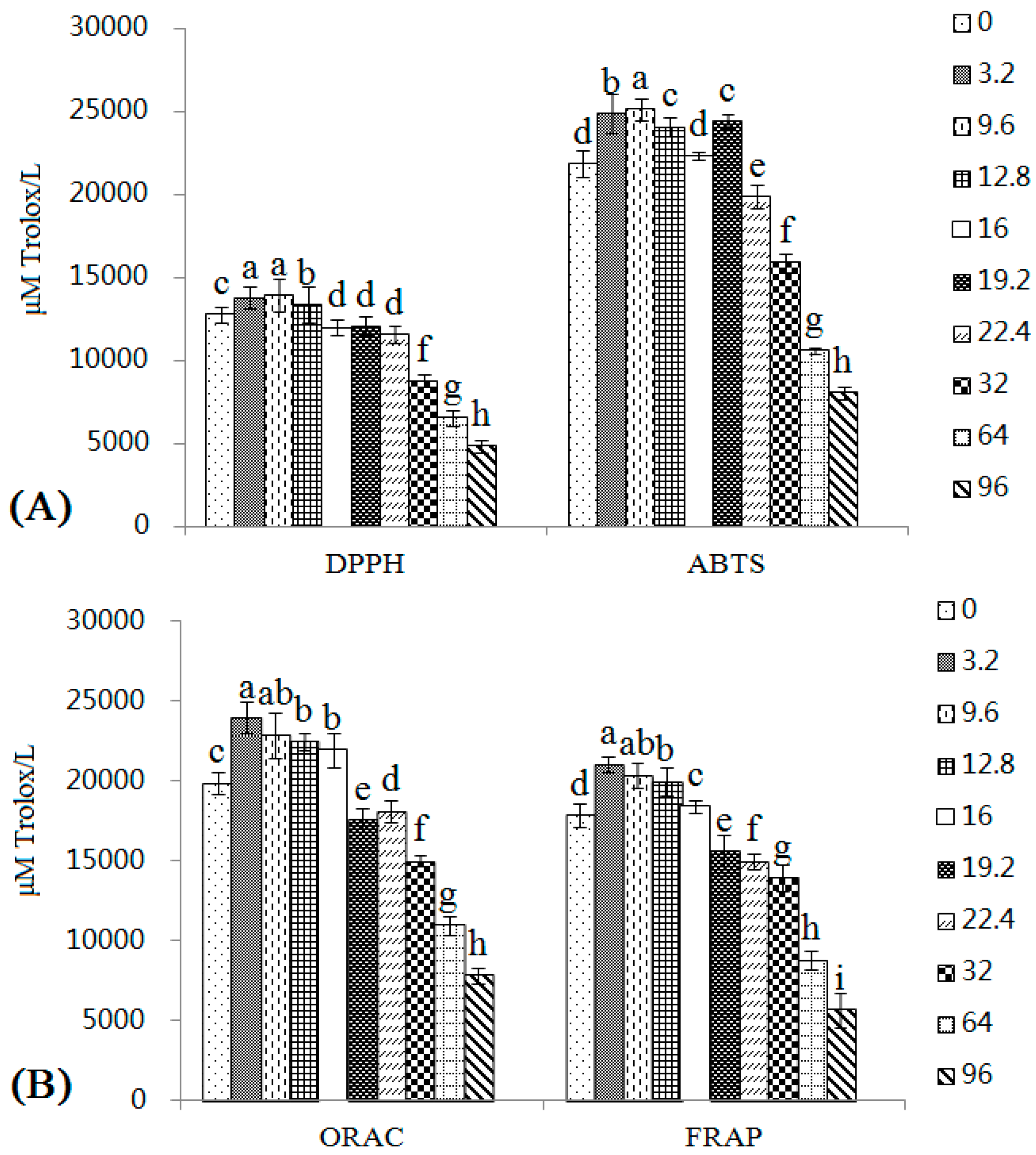Effects of Copper Pollution on the Phenolic Compound Content, Color, and Antioxidant Activity of Wine
Abstract
:1. Introduction
2. Results and Discussion
2.1. Changes in the Total Phenolic (TP), Total Flavonoid (TFA), Total Flavan-3-ol (TFO), and Total Anthocyanin (TA) Contents in Wine with Different Copper Concentrations
2.2. Changes in the Monomeric Phenolic Acid Contents in Wine with Different Copper Concentrations
2.3. Changes in the Monomeric Flavan-3-ol Contents in Wine with Different Copper Concentrations
2.4. Changes in the CIELAB Color Parameters of Wine with Different Copper Concentrations
2.5. Changes in the Antioxidant Activities of Wines with Different Copper Concentrations
3. Experimental Section
3.1. Materials
3.2. Fermentation Experiments
3.3. Measurements of the Total Phenolic (TP), Total Flavonoid (TFA), Total Flavan-3-ol (TFO), and Total Anthocyanin (TA) Concentrations
3.4. Detection of Phenolic Acids and Flavan-3-ols
3.5 Color Parameter Measurements
3.6. Analysis of Antioxidant Capacity
3.7. Analysis of Copper, Iron, Zinc, Manganese, and Cadmium
3.7.1. Sample Pretreatment
3.7.2. ICP-OES Determination
3.8 Analysis of SO2
3.9. Statistical Analysis
4. Conclusions
Supplementary Materials
Acknowledgments
Author Contributions
Conflicts of Interest
References
- Clark, A.; Kontoudakis, N.; Barril, C.; Schmidtke, L.; Scollary, G. Measurement of labile copper in wine by medium exchange stripping potentiometry utilising screen printed carbon electrodes. Talanta 2016, 154, 431–437. [Google Scholar] [CrossRef] [PubMed]
- Jia, B.; Liu, X.Y.; Zhan, J.C.; Li, J.Y.; Huang, W.D. The effect of proanthocyanidins on growth and alcoholic fermentation of wine yeast under copper stress. J. Food Sci. 2015, 80, 1319–1324. [Google Scholar] [CrossRef] [PubMed]
- Provenzano, M.; Bilali, H.; Simeone, V.; Baser, N.; Mondelli, D.; Cesari, G. Copper contents in grapes and wines from a Mediterranean organic vineyard. Food Chem. 2010, 122, 1338–1343. [Google Scholar] [CrossRef]
- Sun, X.Y.; Zhao, Y.; Liu, L.L.; Jia, B.; Zhao, F.; Huang, W.D.; Zhan, J.C. Copper tolerance and biosorption of Saccharomyces cerevisiae during alcoholic fermentation. PLoS ONE 2015, 10, e0128611. [Google Scholar] [CrossRef] [PubMed]
- Sun, X.Y.; Liu, L.L.; Zhao, Y.; Ma, T.T.; Zhao, F.; Huang, W.D.; Zhan, J.C. Effect of copper stress on growth characteristics and fermentation properties of Saccharomyces cerevisiae and the pathway of copper adsorption during wine fermentation. Food Chem. 2016, 192, 43–52. [Google Scholar] [CrossRef] [PubMed]
- Ash, C.; Vacek, O.; Jakšík, O.; Tejnecky, V. Elevated soil copper content in a bohemian vineyard as a result of fungicide application. Soil Water Res. 2012, 7, 151–158. [Google Scholar]
- Probst, B.; Schüler, C.; Joergensen, R. Vineyard soils under organic and conventional management—microbial biomass and activity indices and their relation to soil chemical properties. Biol. Fertil. Soils 2008, 44, 443–450. [Google Scholar] [CrossRef]
- Volpe, M.; Cara, F.; Volpe, F.; Mattia, A.; Serino, V.; Petitto, F.; Zavalloni, C.; Limone, F.; Pellecchia, R.; De Prisco, P.; et al. Heavy metal uptake in the enological food chain. Food Chem. 2009, 117, 553–560. [Google Scholar] [CrossRef]
- García-Esparza, M.; Capri, E.; Pirzadeh, P.; Trevisan, M. Copper content of grape and wine from Italian farms. Food Addit. Contam. 2006, 233, 274–280. [Google Scholar] [CrossRef] [PubMed]
- Tamasi, G.; Pagni, D.; Carapelli, C.; Justice, N.B.; Cini, R. Investigation on possible relationships between the content of sulfate and selected metals in Chianti wines. J. Food Compos. Anal. 2010, 23, 333–339. [Google Scholar] [CrossRef]
- Mirlean, N.; Roisenberg, A.; Chies, J. Metal contamination of vineyard soils in wet subtropics (southern Brazil). Environ. Pollut. 2007, 149, 10–17. [Google Scholar] [CrossRef] [PubMed]
- Ferreira, J.; Toit, M.; Toit, W. The effects of copper and high sugar concentrations on growth, fermentation efficiency and volatile acidity production of different commercial wine yeast strains. Aust. J. Grape Wine Res. 2006, 12, 50–56. [Google Scholar] [CrossRef]
- Sun, X.; Zhao, F.; Ma, T.; Wang, L.; Wang, C.; Sun, Y.; Zhan, J.C. Analysis of the copper content of part of China’s main wine regions. Mod. Food Sci. Technol. 2015, 31, 278–284. [Google Scholar]
- Al Nasir, F.; Jiries, A.G.; Batarseh, M.L.; Beese, F. Pesticides and trace metals residue in grape and home made wine in Jordan. Environ. Monit. Assess. 2001, 66, 253–263. [Google Scholar] [CrossRef] [PubMed]
- Marengo, E.; Aceto, M. Statistical investigation of the differences in the distribution of metals in Nebbiolo-based wines. Food Chem. 2003, 81, 621–630. [Google Scholar] [CrossRef]
- Sauvage, L.; Frank, D.; Stearne, J.; Millikan, M. Trace metal studies of selected white wines: An alternative approach. Anal. Chim. Acta 2002, 458, 223–230. [Google Scholar] [CrossRef]
- Sun, X.Y.; Li, L.; Ma, T.T.; Zhao, F.; Yu, D.; Huang, W.D.; Zhan, J.C. High hydrostatic pressure treatment: An artificial accelerating aging method which did not change the region and variety non-colored phenolic characteristic of red wine. Innov. Food Sci. Emerg. Technol. 2016, 33, 123–134. [Google Scholar] [CrossRef]
- Ma, T.T.; Sun, X.Y.; Gao, G.T.; Wang, X.Y.; Liu, X.Y.; Du, G.R.; Zhan, J.C. Phenolic characterisation and antioxidant capacity of young wines made from different grape varieties grown in Helanshan Donglu wine zone (China). S. Afr. J. Enol. Vitic. 2014, 35, 321–331. [Google Scholar] [CrossRef]
- Isabelle, M.; Lee, B.; Ong, C.; Liu, X.; Huang, D. Peroxyl radical scavenging capacity, polyphenolics, and lipophilic antioxidant profiles of mulberry fruits cultivated in southern China. J. Agric. Food Chem. 2009, 56, 9410–9416. [Google Scholar] [CrossRef] [PubMed]
- Gorinstein, S.; Goldblum, A.; Kitov, S.; Deutsch, J.; Loinger, C.; Cohen, S.; Tabakman, H.; Stiller, A.; Zykerman, A.; Loinger, C.; et al. The relationship between metals, polyphenols, nitogenous substances and treatment of red and white wines. Am. J. Enol. Vitic. 1984, 35, 9–15. [Google Scholar]
- Sun, X.Y.; Li, L.; Ma, T.T.; Liu, Y.Y.; Huang, W.D.; Zhan, J.C. Profiles of phenolic acids and flavan-3-ols for select Chinese red wines: A comparison and differentiation according to geographic origin and grape variety. J. Food Sci. 2015, 80, 2170–2179. [Google Scholar] [CrossRef] [PubMed]
- Robinson, N.; Winge, D. Copper metallochaperones. Annu. Rev. Biochem. 2010, 79, 537–562. [Google Scholar] [CrossRef] [PubMed]
- Clark, A.; Grant-Preece, P.; Cleghorn, N.; Scollary, G. Copper(II) addition to white wines containing hydrogen sulfide: Residual copper concentration and activity. Aust. J. Grape Wine Res. 2015, 21, 30–39. [Google Scholar] [CrossRef]
- Clark, A.; Wilkes, E.; Scollary, G. Chemistry of copper in white wine: A review. Aust. J. Grape Wine Res. 2015, 21, 339–350. [Google Scholar] [CrossRef]
- George, N.; Clark, A.; Prenzler, P.; Scollary, G. Factors influencing the production and stability of xanthylium cation pigments in a model white wine system. Aust. J. Grape Wine Res. 2006, 12, 57–68. [Google Scholar] [CrossRef]
- Clark, A.; Scollary, G. Copper(II)-mediated oxidation of (+)-catechin in a model white wine system. Aust. J. Grape Wine Res. 2002, 8, 186–195. [Google Scholar] [CrossRef]
- Vasconcelos, M.; Azenha, M.; Freitas, V. Role of polyphenols in copper complexation in red wines. J. Agric. Food Chem. 1999, 47, 2791–2796. [Google Scholar] [CrossRef] [PubMed]
- Pohl, P.; Sergiel, I. Evaluation of the total content and the operationally defined species of copper in beers and wines. J. Agric. Food Chem. 2009, 57, 9378–9384. [Google Scholar] [CrossRef] [PubMed]
- Brandolini, V.; Tedeschi, P.; Capece, A.; Maietti, A.; Mazzotta, D.; Salzano, G. Saccharomyces cerevisiae wine strains differing in copper resistance exhibit different capability to reduce copper content in wine. World J. Microbiol. Biotechnol. 2002, 18, 499–503. [Google Scholar] [CrossRef]
- Pérez-Caballero, V.; Ayala, F.; Echávarri, J.F.; Negueruela, A.I. Proposal for a new standard OIV method for determination of chromatic characteristics of wine. Am. J. Enol. Vitic. 2003, 54, 59–62. [Google Scholar]
- Wang, L.H.; Sun, X.Y.; Li, F.; Yu, D.; Liu, X.Y.; Huang, W.D.; Zhan, J.C. Dynamic changes in phenolic compounds, colour and antioxidant activity of mulberry wine during alcoholic fermentation. J. Funct. Foods 2015, 18, 254–265. [Google Scholar] [CrossRef]
- Li, J.C.; Li, S.Y.; He, F.; Yuan, Z.Y.; Liu, T.; Reeves, M.; Duan, C.Q. Phenolic and chromatic properties of Beibinghong red ice wine during and after vinification. Molecules 2016, 21, 431. [Google Scholar] [CrossRef] [PubMed]
- Ma, T.T.; Sun, X.Y.; Zhao, J.M.; You, Y.L.; Lei, Y.S.; Gao, G.T.; Zhan, J.C. Nutrient compositions and antioxidant capacity of Kiwifruit (Actinidia) and their relationship with flesh color and commercial value. Food Chem. 2017, 218, 294–304. [Google Scholar] [CrossRef] [PubMed]
- Li, H.; Guo, A.Q.; Wang, H. Mechanisms of oxidative browning of wine. Food Chem. 2008, 108, 1–13. [Google Scholar] [CrossRef]
- Zou, J.; Peng, Z.; Du, H.; Duan, C.; Reeves, M.; Pan, Q. Elemental patterns of wines, grapes, and vineyard soils from Chinese wine-producing regions and their association. Am. J. Enol. Vitic. 2012, 63, 232–240. [Google Scholar] [CrossRef]
- Cheng, J.; Liang, C. The variation of mineral profiles from grape juice to monovarietal cabernet sauvignon wine in the vinification process. J. Food Process. Preserv. 2012, 36, 262–266. [Google Scholar] [CrossRef]
- Gómez, M.; Brandt, R.; Jakubowski, N.; Andersson, J. Changes of the metal composition in German white wines through the winemaking process: A study of 63 elements by inductively coupled plasma-mass spectrometry. J. Agric. Food Chem. 2004, 52, 2953–2961. [Google Scholar]
- Prior, L.; Wu, X.; Schaich, K. Standardized methods for the determination of antioxidant capacity and phenolics in foods and dietary supplements. J. Agric. Food Chem. 2005, 53, 4290–4302. [Google Scholar] [CrossRef] [PubMed]
- Du, G.; Zhan, J.; Li, J.Y.; You, Y.L.; Zhao, Y.; Zhao, N.; Huang, W.D. Effect of grapevine age on the aroma compounds in ‘Beihong’ wine. S. Afr. J. Enol. Vitic. 2012, 33, 7–13. [Google Scholar]
- Zhang, Q.W.; Sun, X.Y.; Sheng, Q.M.; Chen, J.Q.; Huang, W.D.; Zhan, J.C. Effect of suspension freeze-concentration technology on the quality of wine. S. Afr. J. Enol. Vitic. 2016, 37, 39–46. [Google Scholar] [CrossRef]
- Singleton, V.L.; Rossi, J.A. Colorimetry of total phenolics with phosphomolybdic phosphotungstic acid reagents. Am. J. Enol. Vitic. 1965, 16, 144–158. [Google Scholar]
- Jia, Z.S.; Tang, M.C.; Wu, J.M. The determination of flavonoid contents in mulberry and their scavenging effects on superoxide radicals. Food Chem. 1999, 64, 555–559. [Google Scholar]
- Li, Y.G.; Tanner, G.; Larkin, P. The DMACA-HCl protocol and the threshold proanthocyanidin content for bloat safety in forage legumes. J. Sci. Food Agric. 1996, 70, 89–101. [Google Scholar] [CrossRef]
- Lee, J.; Durst, R.; Wrolstad, R. Determination of total monomeric anthocyanin pigment content of fruit juices, beverages, natural colorants, and wines by the pH differential method: Collaborative study. J. AOAC Int. 2005, 88, 1269–1278. [Google Scholar] [PubMed]
- Ma, T.T.; Tian, C.R.; Luo, J.Y.; Zhou, R.; Sun, X.Y.; Ma, J.J. Influence of technical processing units on polyphenols and antioxidant capacity of carrot (Daucus carrot L.) juice. Food Chem. 2013, 141, 1637–1644. [Google Scholar] [CrossRef] [PubMed]
- Brandwilliams, W.; Cuvelier, M.; Berset, C. Use of a free-radical method to evaluate antioxidant activity. LWT-Food Sci. Technol. 1995, 28, 25–30. [Google Scholar] [CrossRef]
- Re, R.; Pellegrini, N.; Proteggente, A.; Pannala, A.; Yang, M.; Rice-Evans, C. Antioxidant activity applying an improved ABTS radical cation decolorization assay. Free Radic. Biol. Med. 1999, 26, 1231–1237. [Google Scholar] [CrossRef]
- Huang, D.; Ou, B.; Hampsch-Woodill, M.; Flanagan, J.; Prior, R. High-throughput assay of oxygen radical absorbance capacity (ORAC) using a multichannel liquid handling system coupled with a microplate fluorescence reader in 96-well format. J. Agric. Food Chem. 2002, 50, 4437–4444. [Google Scholar] [CrossRef] [PubMed]
- Dinis, T.; Madeira, V.; Almeida, L. Action of phenolic derivates (acetoaminophen, salicylate, and 5-aminosalicylate) as inhibitors of membrane lipid peroxidation and as peroxyl radical scavengers. Arch. Biochem. Biophys. 1994, 315, 161–169. [Google Scholar] [CrossRef] [PubMed]
- Pan, X.; Tang, J.; Chen, Q.; Wu, P. Evaluation of direct sampling method for trace elements analysis in Chinese rice wine by ICP-OES. Eur. Food Res. Technol. 2013, 236, 531–535. [Google Scholar] [CrossRef]
- The National Standard of China. GB/T 15038-2006. Analytical Methods of Wine and Fruit Wine; The National Standard of China: Beijing, China, 2006.
- Tang, Q.; Zhang, C. Data Processing System (DPS) software with experimental design, statistical analysis and data mining developed for use in entomological research. Insect Sci. 2013, 20, 254–260. [Google Scholar] [CrossRef] [PubMed]
Sample Availability: Not available. |





| Phenolic Compounds | Copper Concentrations | Phenolic Compounds | Copper Concentrations | ||||
|---|---|---|---|---|---|---|---|
| Hydroxybenzoic Acids | Low | Medium | High | Flavonols | Low | Medium | High |
| gall | + | −0.5468 | −0.9155 | CAT | + | −0.8743 | −0.7586 |
| prot | + | −0.3135 | −0.9757 | EGC | + | +0.0977 | −0.9960 |
| p-hyd | + | +0.0747 | −0.8834 | EGCG | + | +0.6165 | −0.9540 |
| gent | + | −0.0081 | −0.9757 | EC | + | −0.0032 | −0.8421 |
| vani | + | −0.1141 | −0.9378 | ECG | + | +0.9001 | −0.9918 |
| syri | + | −0.0014 | −0.9844 | TMFA | + | −0.6257 | −0.9579 |
| THBA | + | −0.4473 | −0.9565 | ||||
| Hydroxycinnamic Acid | |||||||
| caff | + | +0.1286 | −0.9748 | TP | + | −0.7783 | −0.9995 |
| p-cou | + | +0.0071 | −0.9933 | TFA | + | −0.6335 | −0.8103 |
| feru | + | +0.0005 | −0.9764 | TFO | + | −0.8351 | −0.9333 |
| sina | − | −0.4541 | −0.9124 | TA | + | +0.6744 | −0.8596 |
| chlo | + | +0.7274 | −0.9227 | ||||
| THCA | + | +0.0265 | −0.9712 | ||||
| TPA | + | −0.3775 | −0.9774 | ||||
| Sample | Element | |||||
|---|---|---|---|---|---|---|
| Copper | Iron | Zinc | Manganese | Cadmium | ||
| Initial juice | 0.22 ± 0.02 d | 6.78 ± 0.21 a | 1.78 ± 0.09 a | 2.28 ± 0.09 a | 0.75 ± 0.04 a | |
| Finished wine | ||||||
| Low | 0.00 mM (0 mg/L) | 0.04 ± 0.00 a | 5.66 ± 0.43 b | 1.44 ± 0.14 b | 1.98 ± 0.19 b | 0.56 ± 0.05 b |
| 0.05 mM (3.2 mg/L) | 0.05 ± 0.01 a | 5.71 ± 0.35 b | 1.35 ± 0.11 b | 1.87 ± 0.22 b | 0.65 ± 0.05 b | |
| Medium | 0.15 mM (9.6 mg/L) | 0.06 ± 0.01 a | 5.38 ± 0.47 b | 1.52 ± 0.15 b | 1.79 ± 0.17 b | 0.58 ± 0.07 b |
| 0.20 mM (12.8 mg/L) | 0.07 ± 0.02 a | 5.74 ± 0.61 b | 1.39 ± 0.19 b | 1.85 ± 0.14 b | 0.49 ± 0.04 b | |
| 0.25 mM (16.0 mg/L) | 0.11 ± 0.02 b | 5.41 ± 0.41 b | 1.45 ± 0.09 b | 1.91 ± 0.21 b | 0.55 ± 0.08 b | |
| 0.30 mM (19.2 mg/L) | 0.15 ± 0.03 bc | 5.32 ± 0.34 b | 1.51 ± 0.12 b | 1.78 ± 0.24 b | 0.59 ± 0.05 b | |
| 0.35 mM (22.4mg/L) | 0.16 ± 0.02 c | 5.56 ± 0.55 b | 1.45 ± 0.14 b | 1.89 ± 0.18 b | 0.61 ± 0.04 b | |
| High | 0.50 mM (32 mg/L) | 2.18 ± 0.19 e | 5.78 ± 0.37 b | 1.56 ± 0.11 b | 1.99 ± 0.18 b | 0.63 ± 0.06 b |
| 1.00 mM (64 mg/L) | 4.67 ± 0.23 f | 5.89 ± 0.44 b | 1.58 ± 0.09 b | 2.01 ± 0.25 b | 0.64 ± 0.04 b | |
| 1.50 mM (96 mg/L) | 7.59 ± 0.44 g | 5.97 ± 0.41 b | 1.55 ± 0.12 b | 2.09 ± 0.18 b | 0.67 ± 0.05 b | |
| Color Parameters | Copper Concentrations | ||
|---|---|---|---|
| Low | Medium | High | |
| L* | + | −0.1107 | −0.9129 |
| a* | + | −0.3869 | −0.8722 |
| b* | + | +0.8639 | −0.9686 |
| C* | + | −0.0839 | −0.8791 |
| H* | + | +0.8454 | +0.3778 |
| Antioxidant Activity | Copper Concentrations | ||
|---|---|---|---|
| Low | Medium | High | |
| DPPH | + | −0.4678 | −0.9952 |
| ABTS | + | −0.1099 | −0.9600 |
| ORAC | + | −0.2933 | −0.9953 |
| FRAP | + | −0.4330 | −0.9804 |
© 2017 by the authors. Licensee MDPI, Basel, Switzerland. This article is an open access article distributed under the terms and conditions of the Creative Commons Attribution (CC BY) license (http://creativecommons.org/licenses/by/4.0/).
Share and Cite
Sun, X.; Ma, T.; Han, L.; Huang, W.; Zhan, J. Effects of Copper Pollution on the Phenolic Compound Content, Color, and Antioxidant Activity of Wine. Molecules 2017, 22, 726. https://doi.org/10.3390/molecules22050726
Sun X, Ma T, Han L, Huang W, Zhan J. Effects of Copper Pollution on the Phenolic Compound Content, Color, and Antioxidant Activity of Wine. Molecules. 2017; 22(5):726. https://doi.org/10.3390/molecules22050726
Chicago/Turabian StyleSun, Xiangyu, Tingting Ma, Luyang Han, Weidong Huang, and Jicheng Zhan. 2017. "Effects of Copper Pollution on the Phenolic Compound Content, Color, and Antioxidant Activity of Wine" Molecules 22, no. 5: 726. https://doi.org/10.3390/molecules22050726






